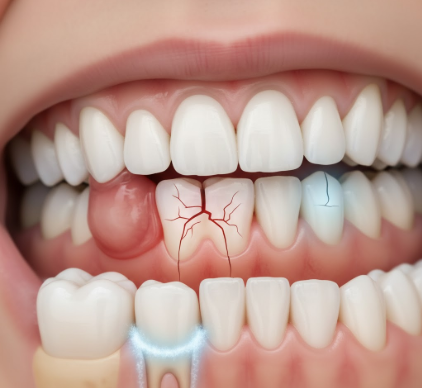That sudden, throbbing, or sharp pain in your mouth – it’s an unwelcome guest, and for many, the immediate thought is: “Oh no, a cavity!” It’s a common reflex, almost ingrained in us from a young age. While cavities, or dental caries, are indeed a frequent cause of toothaches, they are far from the only culprits. Believing that every pang of dental discomfort stems from a cavity is a myth, and one that can sometimes delay getting the right diagnosis and treatment. Understanding the diverse origins of tooth pain is the first step towards effective relief and maintaining better oral health.
Why the Cavity Connection is So Strong
It’s understandable why cavities are the go-to explanation for toothaches. Dentists and public health campaigns have, quite rightly, emphasized the link between sugar, bacteria, and tooth decay for decades. Cavities are, statistically, a very common dental problem affecting people of all ages. When a cavity progresses, it breaches the protective enamel and dentin layers of the tooth, eventually irritating the nerve (pulp) within, leading to pain. This direct cause-and-effect is easy to grasp. Furthermore, the initial symptoms of a developing cavity – perhaps sensitivity to sweets – can often be the first sign of trouble, cementing this association in our minds. However, the world of dental discomfort is much broader.
Beyond the Usual Suspect: Gum Issues
Your gums play a critical role in supporting your teeth, and when they’re unhappy, they can certainly let you know.
Gum disease, in its various stages, is a major non-cavity source of dental pain.
Initially, you might experience
gingivitis, the earliest stage. This is characterized by inflammation of the gums, often causing them to become red, swollen, and prone to bleeding, especially when brushing or flossing. While gingivitis itself might not always cause sharp tooth pain, the inflammation and tenderness can be quite uncomfortable and may be perceived as tooth-related pain.
If gingivitis is left untreated, it can progress to
periodontitis. This is a more serious condition where the inflammation extends deeper, affecting the tissues and bone that support your teeth. Pockets can form between the teeth and gums, harboring bacteria. As gums recede and bone is lost, teeth can become loose. The pain associated with periodontitis can be more pronounced, sometimes a dull, persistent ache, or pain when chewing. Exposed tooth roots due to gum recession are also highly sensitive, leading to pain mistaken for a cavity.
The Sensitive Subject: Dentin Hypersensitivity
Ever taken a sip of iced water or a bite of hot soup and felt a short, sharp jolt of pain in your tooth? This is often
dentin hypersensitivity, not necessarily a cavity. Your teeth are made of layers. Beneath the hard outer enamel is a layer called dentin, which is more porous and contains microscopic tubules. These tubules lead directly to the tooth’s nerve. When enamel wears down or gums recede, exposing the dentin, external stimuli like temperature changes or certain foods can travel through these tubules and trigger the nerve, causing that characteristic sharp, temporary pain.
What causes enamel to wear or dentin to become exposed? Several factors:
- Gum recession: As mentioned, this exposes the root surface, which is covered by cementum (softer than enamel) and can easily wear away to expose dentin.
- Enamel erosion: Acidic foods and drinks (like citrus fruits, sodas, wine) can gradually dissolve enamel. Conditions like acid reflux or bulimia also contribute.
- Aggressive brushing: Using a hard-bristled toothbrush or brushing too vigorously can wear away enamel and cause gums to recede.
- Teeth grinding (bruxism): This can wear down enamel over time.
- Cracked teeth or fillings: These can expose dentin.
Cracks and Fractures: The Hidden Troublemakers
A
cracked or fractured tooth can be a source of significant and often perplexing pain. Unlike a cavity that develops gradually, a crack can occur suddenly due to trauma (like a fall or a blow to the face), biting down on something unexpectedly hard (like an ice cube or unpopped popcorn kernel), or even as a result of large fillings weakening the tooth structure over time. Extreme temperature changes can also contribute to cracks.
The pain from a cracked tooth can vary. It might be a sharp pain when you bite down in a specific way, which then subsides. It could also be a more constant ache or sensitivity to hot and cold. Sometimes, the crack is so fine that it’s difficult to see even on an X-ray, making diagnosis challenging. If the crack extends into the pulp (the nerve), the pain can be intense and may require root canal treatment or even extraction.
The Nightly Grind: Bruxism’s Toll
Bruxism, the medical term for teeth grinding or clenching, is another common culprit behind toothaches that have nothing to do with decay. Many people grind or clench their teeth unconsciously, often during sleep, due to stress, anxiety, or an abnormal bite. The constant pressure and friction can lead to a host of problems:
- Worn down enamel: Leading to sensitivity.
- Micro-fractures in teeth.
- Muscle pain: The jaw muscles (masseters) can become sore and fatigued, leading to a dull ache that can radiate to the teeth.
- TMJ disorders: Bruxism can strain the temporomandibular joint.
- Headaches: Often tension-type headaches, especially upon waking.
The tooth pain from bruxism is often described as a generalized, dull ache, or increased sensitivity in multiple teeth, rather than a sharp pain in one specific tooth, though this can vary.
When Infection Strikes: Dental Abscesses
A
dental abscess is a pocket of pus caused by a bacterial infection. This is a serious condition that requires prompt dental attention. An abscess can form at the tip of a tooth’s root (periapical abscess) or in the gums next to a tooth root (periodontal abscess). While an untreated cavity can eventually lead to an abscess, abscesses can also arise from trauma to the tooth or from gum disease.
The pain from an abscess is typically severe, persistent, and throbbing. It can make it difficult to bite down, and the affected tooth is often very tender to touch. Other symptoms can include:
- Swelling in the gum, jaw, or face
- A pimple-like bump on the gum that may ooze pus
- Fever
- Swollen lymph nodes under the jaw or in the neck
- A foul taste or smell in the mouth
Important: A dental abscess is a serious infection that can spread to other parts of your body if left untreated. If you suspect you have an abscess, characterized by severe, throbbing pain, swelling, or fever, seek dental care immediately. Do not attempt to pop an abscess yourself.
Wisdom Tooth Woes
Impacted wisdom teeth (third molars) are notorious for causing pain. When these teeth don’t have enough room to erupt properly into the mouth, they can become trapped (impacted) in the jawbone or gums. This can lead to various problems:
- Pain and pressure: As the wisdom tooth tries to push through, it can exert pressure on adjacent teeth and cause a dull ache or sharp pain in the back of the jaw.
- Pericoronitis: This is inflammation and infection of the gum tissue around a partially erupted wisdom tooth. It can cause significant pain, swelling, bad taste, and difficulty opening the mouth.
- Damage to adjacent teeth: An impacted wisdom tooth can push against the neighboring molar, potentially causing damage or resorption.
- Cyst formation: Though less common, a cyst can develop around an impacted wisdom tooth.
Referred Pain: Sinus Infections and TMJ
Sometimes, the source of what feels like a toothache isn’t in your teeth at all.
Sinus infections (sinusitis) can cause pain in the upper back teeth because the roots of these teeth are very close to the maxillary sinuses. When your sinuses become inflamed and congested, the pressure can radiate to these tooth roots, mimicking a toothache. Typically, if it’s sinus-related, you’ll also have other sinus symptoms like a stuffy or runny nose, facial pressure, and possibly a headache. The pain might feel worse when you bend over or move your head suddenly.
Temporomandibular joint (TMJ) disorders can also cause pain that feels like it’s coming from your teeth. The TMJ is the joint that connects your jawbone to your skull. Problems with this joint or the surrounding muscles can lead to pain in the jaw, face, ear, and, yes, even the teeth. This pain can be a dull ache or sharp, and might be accompanied by clicking or popping sounds in the jaw, difficulty opening or closing your mouth, or pain when chewing.
Other Potential Causes
A few other situations can lead to tooth pain without a cavity being the direct cause:
- Receding Gums: Already touched upon, but worth reiterating as a direct cause of sensitivity pain as roots become exposed. This can happen due to gum disease, aggressive brushing, or even genetics.
- Worn or Damaged Fillings/Crowns: Over time, dental restorations can wear down, chip, or become loose. This can create gaps where bacteria can enter, leading to sensitivity or pain. It can also irritate the surrounding gum tissue. Sometimes the underlying tooth structure might develop a new issue.
- Food Impaction: Getting a piece of food, like a popcorn husk, stuck between teeth or under the gum line can cause localized pain, inflammation, and pressure until it’s removed.
The Critical Role of a Dental Diagnosis
With so many potential culprits, trying to self-diagnose a toothache is often a fruitless and potentially risky endeavor. What might feel like a simple cavity could be a sign of gum disease, a cracked tooth, or even a non-dental issue like sinusitis. Each of these conditions requires a different approach to treatment. An experienced dentist has the tools – like X-rays, clinical examination techniques, and specialized tests – to accurately identify the root cause of your pain.
Accurate diagnosis is key. Only a dental professional can perform the necessary examinations and tests, such as X-rays or bite assessments, to determine the true cause of your toothache. This ensures you receive the most appropriate and effective treatment for your specific condition, preventing further complications.
Delaying a dental visit because you assume it’s “just a small cavity” or hope the pain will go away on its own can allow more serious conditions to worsen. For example, untreated gum disease can lead to tooth loss, and an untreated abscess can lead to a widespread infection.
What to Do When Tooth Pain Strikes (Before Your Dental Visit)
While waiting for your dental appointment, you can try some temporary relief measures. These are not cures, but they might help manage the discomfort:
- Rinse your mouth: Gently rinse with warm salt water (half a teaspoon of salt in 8 ounces of water) to help clean the area and soothe inflammation.
- Floss gently: If you suspect food impaction, try to gently dislodge it with dental floss.
- Avoid triggers: Steer clear of very hot, cold, sweet, or acidic foods and drinks if they worsen the pain.
- Over-the-counter pain relievers: Medications like ibuprofen or acetaminophen can help reduce pain and inflammation, but follow dosage instructions carefully and remember they only mask the symptom, not treat the cause.
- Cold compress: Applying a cold compress or ice pack wrapped in a cloth to the outside of your cheek for 15-20 minutes at a time can help reduce swelling and numb the area.
Most importantly, schedule an appointment with your dentist as soon as possible. Don’t let fear or assumptions prevent you from getting the care you need.
Conclusion: Look Beyond the Cavity
Toothaches are a clear signal that something isn’t right in your oral environment, or sometimes, even elsewhere in your head and neck region. While cavities are a significant player, they are by no means the only actor on this stage. From gum inflammation and tooth sensitivity to cracks, grinding, infections, and even referred pain from your sinuses, the reasons for dental discomfort are varied and complex.
Understanding this diversity empowers you to move beyond the “it must be a cavity” mindset. The next time you experience a toothache, remember the broad spectrum of possibilities and prioritize a visit to your dentist. They are your best ally in accurately diagnosing the problem and providing the targeted treatment you need to restore comfort and protect your long-term oral health. Regular dental check-ups and good oral hygiene practices are, of course, fundamental in preventing many of these painful scenarios from arising in the first place.









